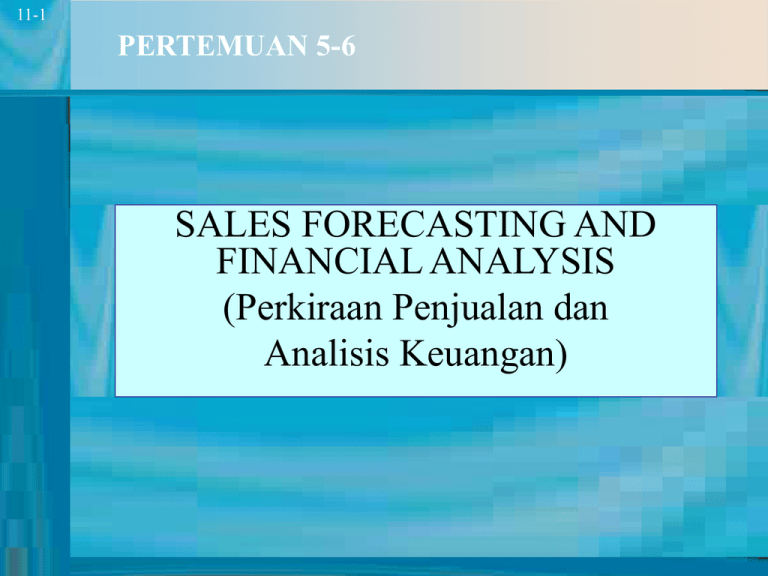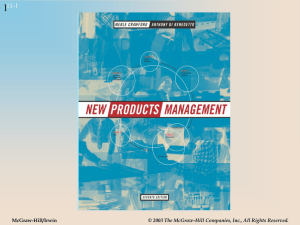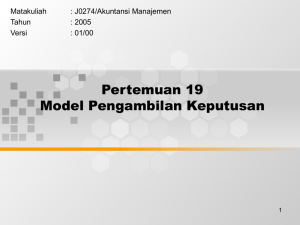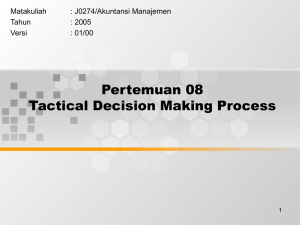SALES FORECASTING AND FINANCIAL ANALYSIS (Perkiraan Penjualan dan Analisis Keuangan)
advertisement

111-1 PERTEMUAN 5-6 SALES FORECASTING AND FINANCIAL ANALYSIS (Perkiraan Penjualan dan Analisis Keuangan) 211-2 Tujuan Instruksional Khusus • Mahasiswa mampu memperkirakan penjualan produk baru 311-3 Proses Pengambilan Keputusan yang Rasional • Mengenali Problem Keputusan • Mendifinisikan ‘goal’ atau obyektif • Mengumpulkan semua Informasi yang Relevan • Mengindentifikasikan satu set alternatif keputusan yang layak • Memilih Kriteria Keputusan yang digunakan • Memilih alternatif yang paling baik? 411-4 Why Financial Analysis for New Products is Difficult • Target users don’t know. • If they know they might not tell us. • Poor execution of market research. • Market dynamics. • Uncertainties about marketing support. • Biased internal attitudes. • Poor accounting. • Rushing products to market. • Basing forecasts on history. • Technology revolutions. 511-5 Forecasters Are Often Right Figure 11.1 In 1967 they said we would have: • Artificial organs in humans by 1982. • Human organ transplants by 1987. • Credit cards almost eliminating currency by 1986. • Automation throughout industry including some managerial decision making by 1987. • Landing on moon by 1970. • Three of four Americans living in cities or towns by 1986. • Expenditures for recreation and entertainment doubled by 1986. 611-6 Forecasters Can Be Very Wrong They also said we would have: • Permanent base on moon by 1987. • Manned planetary landings by 1980. • Most urbanites living in high-rises by 1986. • Private cars barred from city cores by 1986. • Primitive life forms created in laboratory by 1989. • Full color 3D TV globally available. Source: a 1967 forecast by The Futurist journal. Note: about two-thirds of the forecasts were correct! Figure 11.1 (cont’d.) 711-7 Commonly Used Forecasting Techniques Figure 11.2 Technique Simple Regression Multiple Regression Time Horizon* Short Short-medium Cost Low Moderate Econometric Analysis Simple time series Advanced time series (e.g., smoothing) Jury of executive opinion Scenario writing Delphi probe Short-medium Moderate to high Short Short-medium Medium Very low Low to high, depending on method Low Medium-long Long Moderately high Moderately high Comments Easy to learn More difficult to learn and interpret Complex Easy to learn Can be difficult to learn but results are easy to interpret Interpret with caution Can be complex Difficult to learn and interpret 811-8 Handling Problems in Financial Analysis • Improve your existing new products process. • Use the life cycle concept of financial analysis. • Reduce dependence on poor forecasts. – Forecast what you know. – Approve situations, not numbers (recall Campbell Soup example) – Commit to low-cost development and marketing. – Be prepared to handle the risks. – Don’t use one standard format for financial analysis. – Improve current financial forecasting methods. 911-9 A-T-A-R Model Results: Bar Chart Format 100% 90% 80% 70% 60% 50% 40% 30% 20% 10% 0% Figure 11.3 0.9 0.603 Aware Available 0.0965 0.0614 Trial Repeat 11-10 10 Bass Model Forecast of Product Diffusion Figure 11.4 11-11 11 The Life Cycle of Assessment Figure 11.5 Calculating New Product’s Required Rate of Return 11-12 12 Figure 11.6 % Return Reqd. Rate of Return Cost of Capital Risk Avg. Risk of Firm Risk on Proposed Product 11-13 13 Hurdle Rates on Returns and Other Measures Product A B C Strategic Role or Purpose Sales Combat competitive entry Establish foothold in new market Capitalize on existing markets $3,000,000 $2,000,000 Hurdle Rate Return on Investment 10% 17% $1,000,000 12% Figure 11.8 Market Share Increase 0 Points 15 Points 1 Point Explanation: the hurdles should reflect a product’s purpose, or assignment. Example: we might accept a very low share increase for an item that simply capitalized on our existing market position. 11-14 14 Return to the PIC • Seven-point scoring model: - Management interest - Customer interest - Sustainability of competitive advantage - Technical feasibility - Business case strength - Fit with core competencies - Profitability and impact 11-15 15 Hoechst-U.S. Scoring Model Key Factors Probability of Technical Success Probability of Commercial Success Reward Business-Strategy Fit Strategic Leverage 1 ………. <20% probability <25% probability Small R&D independent of business strategy "One-of-a-kind"/ dead end 4 Rating Scale (from 1 - 10) ………. 7 Figure 11.9 ………. 10 >90% probability >90% probability Payback < 3 years R&D strongly supports business strategy Many proprietary opportunities Source: Adapted from Robert G. Cooper, Scott J. Edgett, and Elko J. Kleinschmidt. Portfolio Management for New Products, McMaster University, Hamilton, Ontario, Canada, 1997, pp. 24-28. 11-16 16 Summary …



